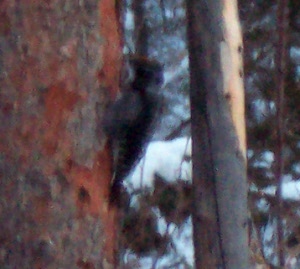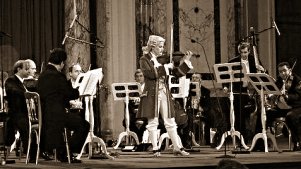

three-toed woodpecker
We had an interesting visitor this afternoon when I came home from work. The sun had already set and all I had was by little digital camera, but the photos show a three-toed woodpecker on a dead tree near the house. It was banging away for at least twenty minutes before I went inside.
It (he) had a bright yellow cap, which is sort of visible in the photos, and you can see the barring on the back which distinguishes him from a black-backed woodpecker. Very cool.
At work, on my Linux box, I listen to music with the Music Player Daemon (MPD) and command-line mpc client. I have managed to build both MPD and mpc on my MacBook Pro, but I haven’t figured out how to configure MPD to play through AirTunes to my stereo. There are commercial solutions, but I don’t want to have to pay money just to listen to my music on my stereo wirelessly. DVD Jon figured out how the AirTunes encryption works, and even wrote a program that you can use at the end of a pipe to stream music to the AirPort. But I haven’t figured out how to glue the MPD audio output together with JustePort.exe so I can play music this way on my Mac.
So what’s wrong with just using iTunes? Well, it’s a snazzy program, but I can’t script it the way I want to, I can’t easily control it from the command line, and it is limited in what file types it can handle (like OGG for example: you can get a plugin that will play OGG, but you can’t burn CDs using those OGG files).
Here’s an example of why I like MPD. The Telarc label recently joined eMusic and I was pleased to discover that Simone Dinnerstein’s recent, well-reviewed interpretation of Bach’s Goldberg Variations appeared on the site. I downloaded it, and also ripped the Bach Edition version (by Pieter-Jan Belder on harpsichord) from the set of Bach CDs I’m working my way through. After listening to them all the way through several times, album by album, I decided I wanted to listen to them with the two albums interlaced so I’d hear the Belder version of a variation followed directly by the Dinnerstein version. There are 32 of them. Imagine how many mouse movements and clicks it would be to get iTunes to do this.
Here’s how I did it with MPD and mpc. It took about 30 seconds, mostly trying to figure out how to get bash to do math.
First, here’s what the playlist looked like initially. The Belder harpsichord version was first, occupying tracks 1-32 in the playlist. Dinnerstein’s 1903 Hamburg Steinway concert grand version occupies tracks 33-64. So I needed to move track 33 to position 2, track 34 to position 4 (because track 2 was now in position 3), 35 to 6. See the pattern? [Dinnerstein track] moved to [([Dinnerstein track] - 32) * 2]
$ mpc playlist >1) Pieter-Jan Belder - Bach: Goldberg Variations - Aria 2) Pieter-Jan Belder - Bach: Goldberg Variations - Variatio 1 3) Pieter-Jan Belder - Bach: Goldberg Variations - Variatio 2 4) Pieter-Jan Belder - Bach: Goldberg Variations - Variatio 3, canone all'unisono ... 33) Simone Dinnerstein - Bach: Goldberg Variations: Aria 34) Simone Dinnerstein - Bach: Goldberg Variations: Variation 1 35) Simone Dinnerstein - Bach: Goldberg Variations: Variation 2 36) Simone Dinnerstein - Bach: Goldberg Variations: Variation 3 (Canone all'Unisono)
And here’s the command to reorder the playlist. The extra dollar signs and parentheses are just bash’s way of escaping parentheses so they’ll be interpreted as an arithmetic expression.
$ for i in `seq 33 64`; do mpc move $i $(($(($i-32))*2)); done
And the playlist afterwards:
$ mpc playlist >1) Pieter-Jan Belder - Bach: Goldberg Variations - Aria 2) Simone Dinnerstein - Bach: Goldberg Variations: Aria 3) Pieter-Jan Belder - Bach: Goldberg Variations - Variatio 1 4) Simone Dinnerstein - Bach: Goldberg Variations: Variation 1 5) Pieter-Jan Belder - Bach: Goldberg Variations - Variatio 2 6) Simone Dinnerstein - Bach: Goldberg Variations: Variation 2 7) Pieter-Jan Belder - Bach: Goldberg Variations - Variatio 3, canone all'unisono 8) Simone Dinnerstein - Bach: Goldberg Variations: Variation 3 (Canone all'Unisono) ...
And then:
$ mpc play

american pie cover
It’s become a Sunday night tradition to bake a pizza using Peter Reinhart’s whole grain pizza dough recipe from his whole grain bread book. Yesterday I bought his 2003 book on pizza. I don’t know that I’ll be giving up the whole grain dough for a more traditional white flour crust, but this evening’s pizza will feature one of the sauces from the book. We had been using a Cook’s Illustrated recipe, but Reinhart says that the two tricks to a great pizza sauce are a bit of acidity (vinegar or lemon juice), and not overcooking the tomatoes. Since we’re using canned crushed tomatoes, which are already cooked during canning, he claims cooking them a second time is unnecessary and will dull the flavor and brightness of the sauce. We’ll find out.
The book starts with his hunt for the best pizza in the world, which takes him to Italy, New Haven, Philadelphia, Providence, New York, Arizona (where the best pizza was, believe it or not), and several other cities. His conclusions at the end are that the are great pizza places that are great because of their context (the neighborhood, local traditions, your memories of the restaurant, etc.) and those that are great because they have a dedicated pizzaiolo that makes every pizza in the place. That sort of pizza parlor is rare, and so most good pizza is contextually good but not great. Regardless, next time I visit any of the cities in the book, I’ll have to check out some of the places he reviews.
The rest of the book discusses what it takes to make good pizza at home, including setting up your oven, and making the dough, sauce, and toppings. He also has a detailed section about grilling pizza using techniques he learned from George Germon in Providence, who invented the style. There are a wide range of interesting recipes after this section. My only complaint with the second part is that the dough recipe ingredients are given only in volumes, not weights. He probably did this to make the recipes seem easier for a more general audience, but weights would have been helpful for those of us who regularly bake bread.
But that’s my only complaint. The first section is entertaining and is a great introduction to the variety of styles of pizza being made around the world, the instructions are solid and easy to follow and there are a lot of recipes to choose from. Finally, the publisher (Ten Speed Press) spent the money for a sewn binding, which means the book should last a lifetime and will lie flat without breaking.
Buddy got some of his stitches out earlier in the week and was given permission by the vet to go for his first run of the year on Thanksgiving. Unfortunately, it was 34 degrees above normal yesterday and above freezing so we decided to take him out to the Creek instead. Piper and Nika have been going with me on most of my trail walks, but this was Buddy’s first experience off the leash. He was nervous at first, and kept running back to the dog yard, but eventually settled into it and had a great time warping around the Creek with the other dogs.
Nika was going crazy; click on the image below to see a close up of her craziness. Piper looks a little freaked out.
photo by xrrr
Note: I started this post way back in July, and after moving into our new house I let it get away from me. I do still hope to continue listening to the whole of the Bach Edition, but as this long delay shows, it’s probably going to take a lot longer than I thought if I’m going to say much of anything about each disc. Yesterday I got Christoph Wolff’s one volume biography of Bach, Johann Sebastian Bach: The Learned Musician, and even though it’s not an analysis of his music (anyone have any suggestions for such a book?), it’s insights into the man may help me in understanding the music. I also got The NPR Guide to Building a Classical CD Collection, and the Violin Concertos are one of the discs that make up the “350 essential works.” The NPR book looks to be pretty good at answering the question of which pieces a classical newbie should listen to, but the CD recommendations themselves aren’t going to be very useful for me. eMusic has a fantastic classical selection, but the major record labels aren’t on there, so I’ll need to find the best from BIS, Naxos and other great independent classical labels.
The fifth CD in the Bach Edition set is a collection of Bach’s violin concertos: BWV 1041, 1042, 1052, 1056 and 1064. The BWV numbers are a way of thematically categorizing (instead of chronologically, like Opus numbers) Bach’s works, so it’s something of a surprise that the numbers aren’t consecutive on this disc. According to this Wikipedia page, BWV 1041, 1042 and 1056 are violin concertos, but BWV 1052, 1057 and 1064 are all categorized with the harpsichord concertos. As noted below, this is because evidence suggests that the harpsichord concertos were written from violin concertos which have been lost (and reconstructed here). This CD doesn’t include BWV 1043–1045, which are classified on the Wikipedia page with the rest of the violin concertos. I’m sure I’ll run into them as I work my way through the corpus but the disconnect is surprising.
Most of the pieces were recorded in 1992 by Camerata Antonio Luco, with Emmy Verhey on violin. The last piece, Concerto for 3 violins, strings, and basso continuo in D Major (BWV 1064) was recorded by the Amsterdam Bach Soloists in 1988.
Concerto for violin, strings and basso continuo in A Minor, BWV 1041
The liner notes for this CD say that this concerto follows a three movement “Vivaldi form” of fast-slow-fast, but that Bach improved on Vivaldi by better integrating the three parts into a unified form. I don’t think I’m a refined enough listener to see what they’re talking about, but I like the comparison to Vivaldi because it’s got the sort of fast pacing and interplay between the instruments that makes Vivaldi enjoyable. The piece starts out with a very lively tempo with different instruments playing against each other. The second part is slower and less remarkable (the liner notes call it a “cantilena”), but the final part returns to the faster rhythm with the soloists alternating with the full ensemble.
Concerto for violin, strings and basso continuo in E Major, BWV 1042
This is a very familiar concerto. The first movement starts with a “tutti theme” repeated throughout the piece, which means that all the instruments play together, rather than individual parts carrying the melody as is common in other sections. The slower second movement is carried by the solo violin, accompanied by a few instruments, harpsichord especially. Both the NPR guide and the liner notes mention how lyrical the solo line is in the second movement. The final movement is in “rondo form”, which the Wikipedia tells me means the principle theme is repeated with contrasting themes interspersed between. For me, I think it’s this form more than anything else that says Baroque to me when I’m listening to Bach. Here, the offsetting main and secondary themes switch back and forth rapidly (four or five times in the three minutes of the movement), keeping the listener interested in the piece without being distracted.
Concerto for violin and strings in D Minor, BWV 1052 (reconstructed from a harpsichord version that Bach arranged from this, missing, original)
Lots of Bach’s music has been lost, and the three remaining pieces on the disc are reconstructed from works for other instruments. The first one, Concerto for violin and strings in D Minor (BWV 1052) is reconstructed from a harpsichord version that exists but which Bach arranged from the original violin version which is no longer around. I suppose that with so much music available, an expert can see how Bach re-wrote is other pieces, and apply the same techniques to reconstruct music that is known to have existed.
I like the first movement of this one a lot. It seems to range wildly around, but always returning to the same melody with different instruments taking it up. And all throughout the movement, there are striking moments where a larger group of musicians plays the same theme. The movement also has an unusual sounding section in the middle where a pair of violins are playing melodies that sound dangerously close to being out of tune. The main melody intrudes a few times, and the movement eventually returns back to normal by the end. I’m sure there are terms for these things, and I’m going to have to figure out what they are so I don’t keep repeating the same awkward phrases over and over again.
The Adagio is much slower (which, it turns out, is what adagio means…) and on initial listens, it seems like there’s a lot less going on. But the slower sections allow the solo violin running through the movement to really carry a lot of emotion. The final movement returns to the faster tempo and interesting interplay between instruments.
Concerto in G Minor (reconstructed from the concerto for harpsichord and strings in F Minor, BWV 1056)
This short concerto is reconstructed from a harpsichord and strings concerto. The second movement also exists as the Sinfonia of Cantata number 156. The second movement also features the string players plucking their instruments behind the solo violin, which lends a very different sound to the piece, and keeps the focus more on the solo violin than if the strings were playing a melody with the bow.
Concerto for three violins in D major (arrangement of the concerto for three harpsichords and strings in C Major, BWV 1064)
The final work is another reconstruction based on evidence that Bach wrote his Concerto for three harpsichords using a version for three violins and strings that no longer exists. It’s a really bright concerto with a quick melody that sounds more like Mozart than Bach to me. Very enjoyable.
Next up would normally be two CDs of Harpsichord Concertos, including a different version of BWV 1056 I heard in the violin concertos. But I think I may jump into the Cantatas for a change of pace from all this orchestral music. I was originally going to listen to the whole thing in order, but I it may be more rewarding to jump around.



